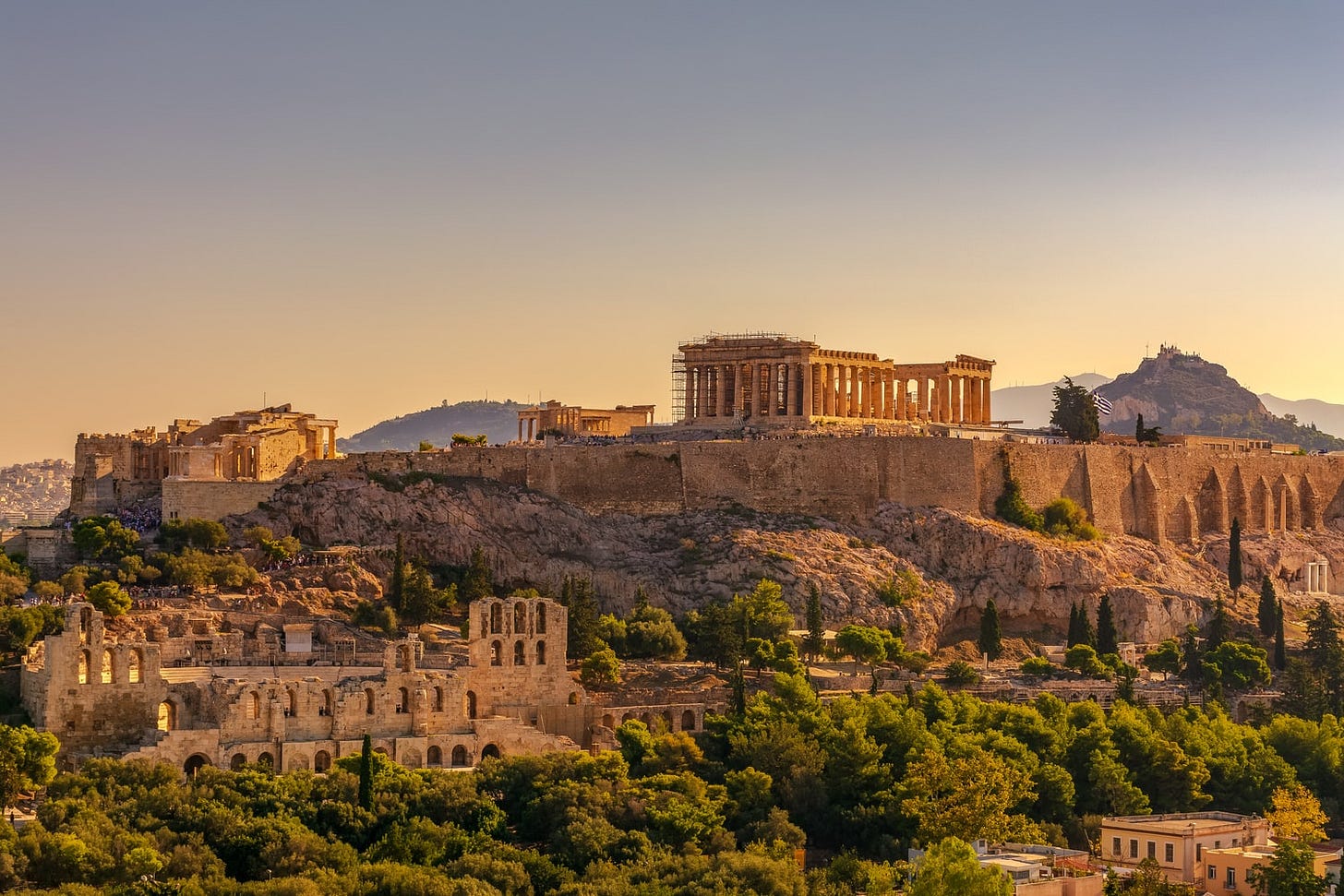An essay in which I explore the implications of the infamous and divisive new statue in Times Square.
Like all ancient peoples, the Athenians took pride in their history and loved their homeland. It’s really only in the modern era that we see a decisive shift towards the fashion of displaying contempt or shame for one’s country and people. The Athenians called themselves “autochthonous” - earth-born, and deeply rooted in the rocky hills of their patria.
Like other Greek cities, Athens was deeply concerned with eunomia - the concept of benevolent and proper public order and government (although the word can properly apply to any natural order). During a transitional period, in which Athens jostled for power and territorial control with her small city-state neighbors, the political order was also in flux. Solon, a prominent and wise citizen called upon to rescue the city from stagnation and dysfunction, crafted a constitution (around the beginning of the 6th century, BC) which empowered the laboring classes. He commanded that it remain in place for 100 years. Soon after, the city gave itself up to tyranny, which didn’t then have the brutal and capricious overtones that it does now. This was followed by even more egalitarian reforms, famously (and not very accurately) establishing Athens’s reputation as the “first democracy.”
Athens had become a city in which any citizen, no matter how poor or uneducated, was guaranteed freedom of public speech; in which polity was no longer debated in the closed and gilded salons of the aristocracy, but openly, in the Assembly, before "carpenter, blacksmith or cobbler, merchant or ship-owner, rich or poor, aristocrat or low-born alike" ; in which no measure could be adopted, no law passed, save by the votes of all the Athenian people. It was a great and noble experiment, a state in which, for the first time, a citizen could feel himself both engaged and in control. Nothing in Athens, or indeed Greece, would ever quite be the same again.
-Tom Holland, Persian Fire
Soon after establishing some of the most radically egalitarian reforms (especially egalitarian for a society which still enthusiastically practiced slavery!) the Athenians met the small army of a regional rival, the city of Thebes. After years of lackluster military performances and embarrassing hoplite combat outcomes (particularly relative to the rigidly martial Spartans), the Athenians - fired by their new sense of freedom and patriotic enthusiasm - inflicted a severe defeat on the Thebans. “And so it was that the Athenians found themselves suddenly a great power… With the tyrant gone… they had suddenly become the best fighters in the world. Held down like slaves, they had shirked and slacked; once they had won their freedom, no citizen could feel but that he was labouring for himself.” (Herodotus, who surely exaggerates the military competence of the Athenian hoplites).
To celebrate their new sense of political agency and their recent battlefield glory they commissioned a massive new public monument: a chariot, pulled by four horses, fashioned completely out of bronze. They placed it directly beyond the gates of the Acropolis, the spiritual and topographical heart of Athens - a monument to “the Sons of Athens.”
The Acropolis - the fortified hill, crowded with temples and statues and shrines commissioned by the wealthiest families in ancient Athens (known as the Eutrapids) and by the governments themselves, both tyrannic and democratic.
Statuary matters. Memorials matter. It is perhaps a measure of our disconnected and spoiled age that many of us can no longer emotionally connect with public monuments which were erected to mark victory or exploration or leadership. This is also the result of decades of intentional political education, imposed on children through classrooms and cartoons and workbooks and films. In these spaces it’s simply unacceptable to offer unabashed praise to American history or the pioneers or the Western wagon trains or the European explorers. We can argue as to the value and worth of these actors, but arguing is besides the point. This political effort isn’t educational in nature, for it only introduces one perspective on these periods. It’s a fundamentally emotional endeavor, an effort to psychological shift entire generations from reverence towards ‘the old’ to enthusiasm for ‘the new.’ The wholesale attempted reprogramming of our population is presumed to be an improvement, and the real goal is to erode the emotional connection that Americans (or Brits, or Canadians, etc.) might have had (used to have) with their past. The past has created the future, and so honoring it is really just a form of gratitude, and a recognition of the struggles of our predecessors (which no one disputes were considerable) but the focal point of the ideologues and the progressive programmers is the future: people are to draw meaning from the society that will be, rather than the one that has been or is.
But how can you memorialize the future, especially when the goals and promises of your political program are so frustratingly vague? The past is no help. After all, if the characters of Thomas Jefferson and Christopher Columbus can be derided as genocidal and oppressive, wait until you read the personal details of Michel Foucault and Jean-Jacques Rousseau and Jean Paul Sartre and Karl Marx and Gayle Rubin and Angela Davis! It’s hardly an exaggeration to say that every intellectual seminarian of the modern left was (or is) an unpleasant, venomous hypocrite… and some of them were perverts. Jefferson might be out, but statues of Michel Foucault would instigate uncomfortable conversations. That won’t work
Monumentalizing is a fundamentally emotional project. It tries to leverage the psychological tendencies of humans to generate a feeling and to validate and strength a value system or an ideology. We can see the direction that progressive ‘memorializers’ (propagandists?) are moving in: the celebration, in film and culture and fiction and even hiring, plus now in statuary, of people simply for their unremarkability (and also for their sex and race - leftists aren’t busily constructing monuments of anonymous white men).
The newest statue in Times Square, monumentalizing… well, it’s not immediately clear, actually, what this is trying to monumentalize
The reactions to Times Square’s newest statue have broken down along class lines (which was predictable) and generated many hilarious memes (“Who was she dad?” “Son, she’s a brave 911 operator that hung up on over 10,000 callers” - this was equally predictable). The cultural gatekeepers have bravely tried to ignore the mockery and confusion, and to pretend as if this is an obviously worthy and important gesture. Of what and for who? That’s not exactly clear, and of course defenders have fallen back on their old standby: abstract and muddled terminology (representation, interrogation, conversations, equity, reflection). But I think we can piece some meaning together from the conversations around a gesture like this.
There are new values, which we’re all being encouraged to embrace. There’s no acknowledgement that there is a concerted political effort to remake our values, and none of the people endeavoring to reshape society’s values would be willing to name exactly what they are, beyond the most general labels. But the secrecy doesn’t change the fact: many people badly want our society to embrace new and different ideas.
A figure like that of this statute would never have been memorialized 100 (or even 20) years ago, so clearly something is changing. The people responsible for the changes dislike stating their program or their ideas too clearly and most of our cultural institutions are on their side. This dislike probably originates in the fact that their program and their ideas are considered to be silly and bizarre by most people, so the programmers must act as if a statue like this is really just a truer expression of society as it is (and as it will be). This statue is important. It provokes important conversations. It’s an important gesture in the never-ending struggle for representation. It honors new faces and tells new kinds of stories. This is all more or less nonsense, of course. The people celebrating this statue don’t want to have important conversations. They want to impose their ideas upon society, with a minimum of discussion or resistance.
But, in a sense, they’re correct. The statue can provoke important conversations. What is it saying?
The New Values (universally promoted but never acknowledged or openly debated) are moral claims. They assume pretensions of automatic ethical superiority, and they do this so that any discussion of their deeper reasoning or the effects of their implementation can be dismissed. Imposing ‘equity’-centered policies on a company is assumed to improve the company (even its profitability!) but whether or not those improvements pan out (they haven’t), the changes must be made. Equity is a moral commandment, just like all the other New Values. This is why leftists dislike debating policy with informed skeptics and opponents. The real-world results of their policies are, for them, beside the point. The policies are rooted in the values, and the values are a priori ethically perfect.
Here are some insights that this statue might generate as to our regime’s New Values:
Certain people, with certain identity features, are entitled to an extra helping of recognition and status and acclaim in order to make up for the errors of history. Whether or not any of the people with these identity features achieve greatness is irrelevant (in fact, mentioning the question is offensive). Their existence (“moving through the world in black / fat / femme-coded bodies”) is enough. Celebrate them. Do it.
Society should do more to construct equality (or, rather, equity). This might seem to militate against the construction of individual statues at all… but there are lots of statues of white men and the propagandists understand that they’ve basically used up their public goodwill when it comes to deleting those. In fact, the public goodwill account is badly overdrawn. Therefore, we need statues of black women, and not hot ones. Even important leaders and innovators don’t sufficiently serve the New Values (too little deconstruction), and there really aren’t that many well-known important black, female historical figures. Hence, an anonymous (and somewhat disgruntled) woman’s body and visage, in 12-ft. tall bronze.
Everything should be deconstructed. The left loves deconstruction. In fact, it can be said without exaggeration to be their greatest source of enthusiasm. The very idea of statues - of important people doing important things being publicly memorialized and therefore helping to define the places at which these memorials rest - is ripe for deconstruction. Leftists love deconstruction because it’s easy and it feels radical (without actually incurring any risk or requiring any deep thought). The hint is in the name, though: deconstruction is a thoroughly negative undertaking. What is being constructed in the place of the deconstructed thing? Construction (positive creation and building) is definitely not a great source of enthusiasm for the left. Ask yourself: what are the great policy triumphs of the nationwide progressive movement which has exercised monopolistic control over more of our institutions and the minds of 100 million for the past decade? Deconstruction is fun and feels exciting. Construction is difficult and boring. Deconstruction > construction, every time!
Achievement = oppression. This is, finally, the fundamental message of this statue. It’s increasingly popular, and it’s very dangerous. The idea is that acclaim and greatness and public recognition are, themselves, invalid. This is a tendency we see pop up again and again on the left, and there’s a reason for that. Athletic championships, debate contests, job interviews - the vast array of social competition is seen as illegitimate. Part of the reason for this lies in the fact that leftists are nearly always educated and financially privileged, and they learn as they’re raised in these circles that a kind of false modesty (pretending to care nothing for status and achievement while caring deeply about these things) is required. The dream of the left is a society is which status hierarchies have been flattened, which is very ironic. After all, their entire political project is essentially a complicated game by educated professionals to gain and consolidate personal social status.













Something I keep noticing is how the denial of hierarchy seems to follow a female-coded impulse though which the excellence of people, and especially of other women, is denied. The evil nature of hierarchy is used to deny excellent women in particular the fruits of their labor, and those women are often, ironically, black or brown. Mediocre women who happen to mostly be white (only because the elite is the least racially diverse) need to pretend they’re not at the top of the hierarchy to justify the continued special favors and denial of the necessity of hierarchy to achieve literally anything at all. I appreciate the continued you give this aspect of leftism.
Statues of imaginary, unaccomplished individuals replacing individuals of great accomplishment aligns with ongoing efforts to demoralize the populace, to undermine our values and normalize youth making no effort to get out of mom's basement.